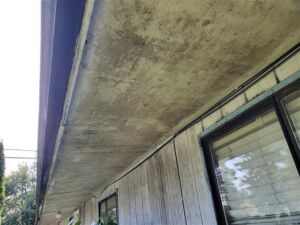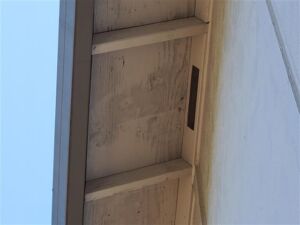
Mold growth on soffits is generally black or dark grey and has a splotchy, semi-circular, and irregular appearance. Gone untreated, mold growth on exterior components can lead to accelerated deterioration over time. In the worst-case scenarios, it can deteriorate the roof framing and sheathing, leading to costly repairs. Additionally, the mold will likely continue to grow, which is aesthetically unpleasing.
The cause of soffit mold typically comes down to two variables: paint quality and dust accumulation. Latex based paint provides a food source for mold. When latex paint is used on a home’s exterior the likelihood that mold growth will occur is increased. For exterior applications oil-based paints and acrylic paints are recommended. These paints are moisture and mildew resistant. Some paints even use antifungal additives to help resist mold growth.
Dust accumulation can also provide a food source for mold and mildew. When dust settles on exterior paint, mold can follow. Dust accumulation can diminish the effectiveness of high-quality and anti-fungal paint.

To remove existing soffit mold, start with a thorough cleaning of the affected areas. Store bought cleaners are available for this purpose, you can also use a combination of dish soap and vinegar. Use a stiff brush to scrub the problem areas until the visible mold is removed. After the areas have been cleaned there are chemical treatments that can be applied to help prevent future mold growth. Adding a coating of an exterior grade paint in these areas will also decrease the likelihood of future mold growth. Some paint manufacturers provide warranties that cover mold growth for a certain period. Because many soffits are two or more stories above the ground it will sometimes be necessary from a safety standpoint to have a qualified company provide a cleaning and sealing service.
People often think that soffit mold is correlated with mold within the attic space. While we do sometimes find apparent mold growth in both areas, this is not always the case, and it is often the result of separate issues. Because soffit mold is outside of the attic airspace, soffit mold alone is unlikely to affect indoor air quality. If you are unsure about the condition of your attic space, you should consider having an inspection of that area performed.
Mold on a home’s soffits and adjacent components is not only unsightly, but it can decrease the serviceable life of the affected areas. While prevention can sometimes be difficult, removal of the mold growth can often be done by a homeowner with relatively little expense. Personal safety is of the utmost importance. Consider hiring a qualified company to perform any repairs that you believe would put you in danger.
